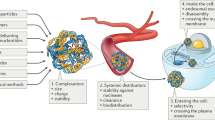Abstract
Cellular reprogramming and stem cell-based therapies have shown tremendous potential in the field of regenerative medicine. To that end, developing tools to control stem cell fate is an attractive area of research for replacing damaged and diseased cells and reestablishing functional connections for tissue repair. Transcription factor (TFs) proteins are well known to regulate gene expression and direct stem cell fate. Inspired by natural TFs, NanoScript, a nanoparticle (NP)-based platform, mimics TFs to afford control over gene expression and stem cell fate for regenerative medicine. Here, we describe the construction of the NanoScript platform, which is designed with tunable properties to replicate the structure and function of TFs to bind to specific portions of the genome and regulate gene expression in a way that does not involve viral delivery.
The original version of this chapter was revised. An erratum to the chapter can be found at DOI: 10.1007/978-1-4939-6840-4_23
An erratum to this chapter can be found at http://dx.doi.org/10.1007/978-1-4939-6840-4_23
Access this chapter
Tax calculation will be finalised at checkout
Purchases are for personal use only
Similar content being viewed by others
References
Reik W (2007) Stability and flexibility of epigenetic gene regulation in mammalian development. Nature 447:425–432
Spitz F, Furlong EEM (2012) Transcription factors: from enhancer binding to developmental control. Nat Rev Genet 13:613–626
Patel S, Jung D, Yin PT, Carlton P, Yamamoto M, Bando T, Sugiyama H, Lee K-B (2014) NanoScript: a nanoparticle-based artificial transcription factor for effective gene regulation. ACS Nano 9:8959–8967
Patel S, Yin PT, Sugiyama H, Lee K-B (2015) Inducing stem cell myogenesis using NanoScript. ACS Nano 9:6909–6917
Patel S, Pongkulapa T, Yin PT, Pandian G, Rathnam C, Bando T, Vaijayanthi T, Sugiyama H, Lee K-B (2015) Integrating epigenetic modulators into NanoScript for enhanced chondrogenesis of stem cells. J Am Chem Soc 137:4598–4601
Patel S, Chueng STD, Yin PT, Dardir K, Song Z, Pasquale N, Kwan K, Sugiyama H, Lee K-B (2015) Induction of stem-cell-derived functional neurons by NanoScript-based gene repression. Angew Chem Int Ed Engl 54:11983–11988
Giljohann DA, Seferos DS, Daniel WL, Massich MD, Patel PC, Mirkin CA (2010) Gold nanoparticles for biology and medicine. Angew Chem Int Ed Engl 49:3280–3294
Colombo M, Carregal-Romero S, Casula MF, Gutiérrez L, Morales MP, Böhm IB, Heverhagen JT, Prosperi D, Parak WJ (2012) Biological applications of magnetic nanoparticles. Chem Soc Rev 41:4306–4334
Lim J, Majetich SA (2013) Composite magnetic–plasmonic nanoparticles for biomedicine: manipulation and imaging. Nano Today 8:98–113
Robertson KD (2002) DNA methylation and chromatin: unraveling the tangled web. Oncogene 21:5361–5379
Dervan PB, Edelson BS (2003) Recognition of the DNA minor groove by pyrrole-imidazole polyamides. Curr Opin Struct Biol 13:284–299
Melander C, Burnett R, Gottesfeld JM (2004) Regulation of gene expression with pyrrole_imidazole polyamides. J Biotechnol 112:195–220
Hoelz A, Debler EW, Blobel G (2011) The structure of the nuclear pore complex. Annu Rev Biochem 80:613–643
Zaret KS, Carroll JS (2011) Pioneer transcription factors: establishing competence for gene expression. Genes Dev 25:2227–2241
Portela A, Esteller M (2010) Epigenetic modifications and human disease. Nat Biotechnol 28:1057–1068
Lévy R, Shaheen U, Cesbron Y, Sée V (2010) Gold nanoparticles delivery in mammalian live cells: a critical review. Nano Rev 1. doi:10.3402/nano.v1i0.4889
Ter-Avetisyan G et al (2009) Cell entry of arginine-rich peptides is independent of endocytosis. J Biol Chem 284:3370–3378
Newmeyer DD, Forbes DJ (1988) Nuclear import can be separated into distinct steps in vitro: nuclear pore binding and translocation. Cell 52:641–653
Pilch DS, Poklar N, Baird EE, Dervan PB, Breslauer KJ (1999) The thermodynamics of polyamide−DNA recognition: hairpin polyamide binding in the Minor Groove of duplex DNA. Biochemistry 38:2143–2151
Nyanguile O, Uesugi M, Austin DJ, Verdine GL (1997) A nonnatural transcriptional coactivator. Proc Natl Acad Sci 94:13402–13406
Chen G, Courey AJ (2000) Groucho/TLE family proteins and transcriptional repression. Gene 249:1–16
Shah BP, Pasquale N, De G, Tan T, Ma J, Lee K-B (2014) Core–shell nanoparticle-based peptide therapeutics and combined hyperthermia for enhanced cancer cell apoptosis. ACS Nano 8:9379–9387
Sun S, Zeng H, Robinson DB, Raoux S, Rice PM, Wang SX, Li G (2004) Monodisperse MFe2O4 (M = Fe, Co, Mn) nanoparticles. J Am Chem Soc 126:273–279
Author information
Authors and Affiliations
Corresponding author
Editor information
Editors and Affiliations
Rights and permissions
Copyright information
© 2017 Springer Science+Business Media LLC
About this protocol
Cite this protocol
Dardir, K., Rathnam, C., Lee, KB. (2017). NanoScript: A Versatile Nanoparticle-Based Synthetic Transcription Factor for Innovative Gene Manipulation. In: Petrosko, S., Day, E. (eds) Biomedical Nanotechnology. Methods in Molecular Biology, vol 1570. Humana Press, New York, NY. https://doi.org/10.1007/978-1-4939-6840-4_16
Download citation
DOI: https://doi.org/10.1007/978-1-4939-6840-4_16
Published:
Publisher Name: Humana Press, New York, NY
Print ISBN: 978-1-4939-6838-1
Online ISBN: 978-1-4939-6840-4
eBook Packages: Springer Protocols




